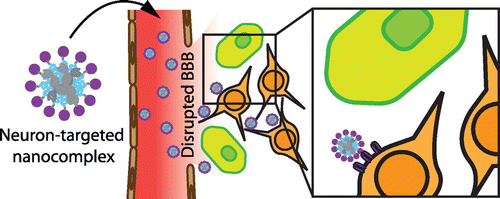Curbing the life-long effects of traumatic brain injury

A fall down the stairs, a car crash, a sports injury or an explosive blast can all cause traumatic brain injury (TBI). Patients often recover. But in the days or weeks following the hit, they can develop other serious, chronic conditions, such as depression and thinking and memory problems. Now scientists report in the journal ACS Nano a potential way to reduce these effects with a neuron-targeting nanoparticle, using an animal model of TBI.
When someone suffers from a head injury, the damage doesn't necessarily stop after the initial blow. The jolt can cause a cascade of after-effects—such as inflammation and ultimately the death of brain cells—and lead to physical and cognitive conditions that can continue for years. One promising approach to treating these after-effects involves delivering short stretches of RNA that can help shut down this chain reaction. But getting the RNA to the damaged part of the brain is a challenge because of the blood-brain barrier, which separates circulating blood from the fluid around brain cells. Sangeeta N. Bhatia and her colleagues at the Massachusetts Institute of Technology's Institute for Medical Engineering & Science wanted to see if they could rush therapeutic RNA to targeted brain cells soon after an injury while the blood-brain barrier is weakened.
The team, led by postdoctoral researcher Ester Kwon, engineered nanoparticles to target neurons by borrowing a protein from the rabies virus. They also loaded the particles with a strip of RNA designed to inhibit the production of a protein associated with neuronal cell death. When given to mice intravenously within a day of receiving a brain injury, the nanoparticles left the circulation and accumulated in the damaged tissue. Analysis also showed that the levels of the protein that the researchers were trying to reduce dropped by about 80 percent in the injured brain tissue.
More information: Ester J. Kwon et al. Neuron-Targeted Nanoparticle for siRNA Delivery to Traumatic Brain Injuries, ACS Nano (2016). DOI: 10.1021/acsnano.6b03858
Abstract
Traumatic brain injuries (TBIs) affect 2.5 million Americans per year, and survivors of TBI can develop long-term impairments in physical, cognitive, and psychosocial functions. Currently, there are no treatments available to stop the long-term effects of TBI. Although the primary injury can only be prevented, there is an opportunity for intervention during the secondary injury, which persists over the course of hours to years after the initial injury. One promising strategy is to modulate destructive pathways using nucleic acid therapeutics, which can downregulate "undruggable" targets considered difficult to inhibit with small molecules; however, the delivery of these materials to the central nervous system is challenging. We engineered a neuron-targeting nanoparticle which can mediate intracellular trafficking of siRNA cargo and achieve silencing of mRNA and protein levels in cultured cells. We hypothesized that, soon after an injury, nanoparticles in the bloodstream may be able to infiltrate brain tissue in the vicinity of areas with a compromised blood brain barrier (BBB). We find that, when administered systemically into animals with brain injuries, neuron-targeted nanoparticles can accumulate into the tissue adjacent to the injured site and downregulate a therapeutic candidate.
Journal information: ACS Nano
Provided by American Chemical Society





















